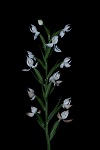Australian Journal of Botany
Volume 66
Number 2 2018
Caladenia is unique among orchids in that it contains both species pollinated by food-foraging insects, and species pollinated by sexual deception, providing the opportunity to investigate the evolution of sexual mimicry. Here, we report a new case of pollination by sexual deception in the Caladenia filamentosa complex, a group with brightly coloured, scented flowers previously thought to be pollinated by food deception. Our findings demonstrated that sexual deception can be achieved without dull-coloured flowers and insectiform labella.
Gibberellic acid (GA3) is a hormone often used in seed science research. Because of its low solubility in water, GA3 is commonly dissolved in a small quantity of ethanol before making up to volume with water. This low concentration of ethanol was found to affect seed germination in Brachyscome and Allittia species, so pure water is recommended for dissolving GA3 in seed trials with these species.
Programmed cell death (PCD) is an organised cellular degradation and may promote sterility during reproductive development. We investigated the cellular changes that lead to the absence of pollen in pistillate flowers of Maytenus obtusifolia and observed that PCD is promoted by autophagy. These results may contribute to a better understand of the cellular bases of plant fertility.
The fine-scale effects of fire heat and their consequences in tropical savannas are poorly understood. We investigated the effect of fire temperature on the survival of exposed seeds of two legume species of the Cerrado (Brazilian savannas). Vegetation gaps were the only places where exposed seeds survived experimental fires and are therefore considered ‘safe sites’.
Metallophytes are plants that are able to tolerate soils with high metal concentrations and therefore have great potential for mine site rehabilitation. However, little is known about native metallophytes in semiarid environments in Australia. Research conducted in the largest Zn/Pb mineralisation zone of Australia (Broken Hill, NSW) found no obligate metallophytes. Nevertheless, they may be present in the wider area, and their identification should be prioritised. Several facultative metallophytes were identified in this study, however, and are useful species to prioritise for future mine rehabilitation efforts.
Inappropriate fire regimes brought about by patterns of human settlement and land-use threaten plant diversity in Mediterranean-type climate regions. We compiled fire-response attribute information for south-west Western Australia’s threatened plant species in combination with a bioregional assessment of variation in fire interval over the last 40 years. Survival of many populations of threatened flora in this biodiversity hotspot will depend on developing appropriate fire regimes that match the regeneration requirements of each species.
Flowers of Habenaria species are characterised by long spurs and mostly pollinated by long-tongued hawkmoths or butterflies, but H. malintana show very short spurs with no nectar or scent. Field experiments and observations revealed that this orchid has completely abandoned sexual reproduction and adopted obligate agamospermy to achieve high reproductive output.
The study is of interest to determine whether variation in the ploidy of natural populations has contributed to the evolution of silver wattle (Acacia dealbata Link); the species is common in forest and woodland communities in Tasmania and likely to dominate on disturbed sites. The present paper has reported the frequency of different cytotypes in 10 populations in south-eastern Tasmania and affirmed that clonal development via suckering is an important reproductive mechanism of this species.
Some insects are parasites capable of inducing galls, which are specialised structures, on their host plants. Insect galls have variable shapes, and here we have investigated the key anatomical steps that lead to the bivalve shape. Lopesia sp., a Diptera: Cecimodyiidae, stimulates the cells of its host plant, Mimosa gemmulata, towards new patterns of divisions and elongation, culminating in the peculiar bivalve-shaped gall.
Cycas megacarpa is an endangered cycad as ~70% of its habitat has been lost. The species is dioecious with separate male and female plants but only a relatively small proportion reproduce at the same time, which may impact on reproductive success. Population sizes vary enormously and there are many very small populations. Genetic diversity is not related to population size but decreases with geographical isolation. There is no geographic genetic differentiation as historically there has been a high level of gene flow among populations.














